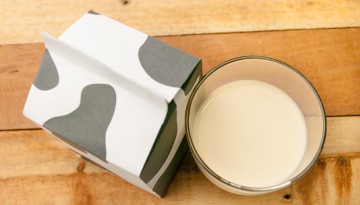Elevated Bacterial Counts Found in Single-Serving Milks
After analyzing pasteurized fluid milk in commercial, paperboard single-serving containers, scientists from Cornell’s Milk Quality Improvement Program have detected higher bacterial counts two weeks after processing than milk packaged in larger containers from the same facilities.
The scientists – part of the Department of Food Science in the College of Agriculture and Life Sciences – believe carton-filling machinery likely contributed to those higher counts in the post-pasteurization process.
The research published Feb. 27 in the Journal of Dairy Science.
“These small paperboard milk containers are typically served in schools,” said senior author Nicole H. Martin ’06, M.S. ’11, Ph.D. ’18, assistant research professor in dairy foods microbiology and the associate director of the Milk Quality Improvement Program. “Since children are important milk consumers, we wanted to take a deeper dive into finding out what was going on.”
Transportation and milk delivery routines to schools have changed in recent years, said Martin Wiedmann, Ph.D. ’97, the Gellert Family Professor in Food Safety (CALS), who directs the Milk Quality Improvement Program, which for more than 50 years has been helping the state’s dairies produce high-quality milk. Rural schools in New York once received fresh milk deliveries every two or three days, but now schools may receive deliveries once a week or less frequently.
“Milk is a perishable product and it is minimally processed, but it does have a shelf life and consumers expect that,” Martin said. “The imbalance of the shelf life between the larger containers and the smaller ones intrigued us.”
The Cornell group recruited four commercial milk processing facilities to collect data on single-serving carton samples of skim, white 1%, chocolate and chocolate 1% milk.
Over two initial sampling visits to four processors, the scientists found higher bacterial counts after seven and 14 days of storage, as well as slightly lower sensory scores (how the milk tasted) compared to high-quality samples.
For the first sampling visit, the Cornell scientists found no gram-negative spoilage (indicating bacterial presence) in any of the facilities’ freshly processed milk. By day 7, one facility saw gram-negative spoilage at 30%, which grew to 41% by day 14. The remaining three facilities saw single-digit gram-negative spoilage scores (3%, 8% and 6%) on day 7, rising to 19%, 23% and 14% by day 14.
The milk also was sampled by trained adult sensory panelists on the Cornell campus – judging against a “gold standard” flavor – to blindly evaluate the taste after seven and 14 days. Milk from the commercial facilities earned high sensory scores for fresh milk and maintained good scores by day 7. Generally, the milk’s taste score dropped slightly in sensory tests by day 14.
The scientists followed up in the commercial facilities and learned that the carton-forming mandrels – those machinery parts that open the small, flat-lying, single-serving carton in the filling process – needed more attention and cleaning. Wiedmann acknowledged that due to its intricacy, the dairy processing equipment for single-serving paperboard cartons is tricky to clean.
“These are complex pieces of equipment,” he said. Members of his program helped to perform cleaning and sanitation at the commercial facilities to ensure consistency and to develop standard protocols.
“In the long term,” Wiedmann said, “our program can help improve the design of this equipment and perhaps make it easier to clean.”
In addition to Martin and Wiedmann, co-authors on the research, “Gram-Negative Postpasteurization Contamination Patterns of Single-Serve Fluid Milk Produced in 4 Different Processing Facilities,” are Tim Lott, Ph.D. ’23; and Alina Stelick, manager of the Cornell Sensory Evaluation Center.
Wiedmann is a faculty fellow at the Cornell Atkinson Center for Sustainability.
This project was funded by the New York Dairy Promotion Order.

